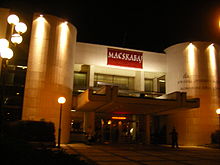Magyars in Slovakia
The Magyars are the largest ethnic minority in Slovakia . According to the 2011 census, 458,467 Magyars lived in the country, making up almost 8.5% of the total population of Slovakia. They live mainly in the south of the country along the border with Hungary , mostly in the districts of Trnavský kraj and Nitriansky kraj and form the majority in Okres Dunajská Streda and Okres Komárno . Most of them are bilingual and speak Slovak as well as Hungarian .
Demographics
| district | number | Hungary | percent |
|---|---|---|---|
| Banskobystrický kraj | 660,563 | 67,596 | 10.2% |
| Bratislavský kraj | 602.436 | 23,888 | 4.0% |
| Košický kraj | 791.723 | 74,743 | 9.4% |
| Nitriansky kraj | 689.867 | 169,460 | 24.6% |
| Prešovský kraj | 814,527 | 646 | 0.1% |
| Trnavský kraj | 554.741 | 120,784 | 21.8% |
| Trenčiansky kraj | 594,328 | 797 | 0.1% |
| Žilinský kraj | 688.851 | 553 | 0.1% |
According to the last census in 2011, there were 458,467 Magyars living in the country, with a share of 8.49%. In 2001 the Magyars with 520,528 members made up 9.67% of the population of Slovakia; In 1991 there were 567,296, with a share of 10.76%. See the table on the right for a presentation of the 2011 census results by district.
The Magyar minority mostly lives along the Hungarian border : in the west this includes the Große Schüttinsel , an area north of it between the Little Danube and the Waag and the area at the lower course of the rivers Waag, Gran and Eipel , about 25-30 kilometers before the Confluence with the Danube . The first two areas mentioned are partly also known as Mattesland (ung. Mátyusföld ). Outside this contiguous area there is another linguistic island in the area of Nitra , ethnologically known as Zobor . In central Slovakia, Hungarians live along the Eipel, from around Lučenec and in the southern halves of the Novohrad and Gemer regions . In eastern Slovakia they can be found around Rožňava and Moldava nad Bodvou , southwest and south of Košice . In addition, there is an area in the eastern Slovak lowlands along the rivers Bodrog and Latorica , which the Magyar side also calls Bodrogköz (Slov. Medzibodrožie).
Cities with a Hungarian share of more than 10%
All cities (but not simple municipalities) are listed here that had a Hungarian share of 10% or more in the 2001 census. With a share of 20% or more, the Hungarian language may be used officially by the municipality.
|
|
|
The following cities had more than 5,000 members of the Magyar minority, but had a share of less than 10%:
- Bratislava (Hungarian Pozsony ) - 16,541 pop., 3.84%
- Košice (Hungarian cash desk ) - 8,490 inhabitants, 3.79%
politics
Minority issues in Slovakia - as for the Slovaks in Hungary - are still complicated and not without conflicts.
Today the Magyar minority is represented by two political parties:
- Party of the Hungarian coalition (Hungarian Magyar Koalíció Pártja , Slov. Strana maďarskej koalície , official abbreviation SMK-MKP), currently not in parliament , was represented in government from 1998-2006
- Most – Híd (Slov. And Hungarian for the word “bridge”), was represented in parliament with 13 seats before the election on February 29, 2020, and was represented in the government from 2010 to 2012 and from 2016 to 2020.
culture and education
- Csemadok , a cultural association for the Hungarian minority in Slovakia
- Kalligram , a publishing house in Bratislava
- Madách , former publisher
- Rádio Patria, a program of the Slovak Radio , which broadcasts mostly in Hungarian
- Új Szó (German New Word ), a Hungarian-language newspaper, published in Bratislava
- János Selye University , Hungarian-speaking university in Komárno
- Vasárnap (German Sunday ), a Hungarian-language weekly magazine
Lessons are held in Hungarian at around 580 schools, and around 200 other schools are bilingual (Slovak-Hungarian).
Personalities
Born before 1918
Born after 1918
Individual evidence
- ↑ PDF at portal.statistics.sk ( Memento from October 6, 2014 in the Internet Archive )
- ↑ PDF at scitanie2011.sk
-
↑ cf. z. B. Ralf Leonhard: Hungary in Slovakia - Identity and Aggression. In: TAZ, January 19, 2009;
"The Burgenland was still bearable for Hungary". Peter Haslinger in derstandard online, August 31, 2009.


